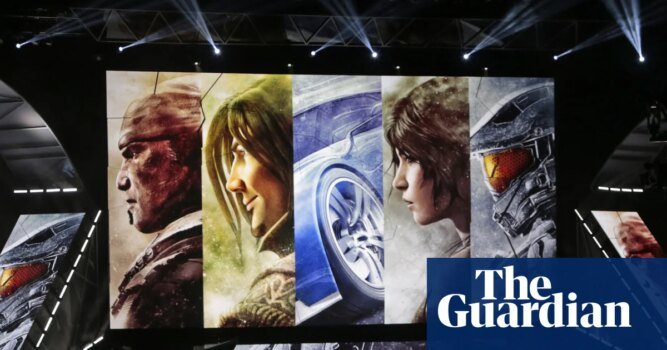Almost 20 years ago (on 1 December 2005, to be precise), I was at my very first video game console launch party somewhere around London’s Leicester Square. The Xbox 360 arrived on 22 November 2005 in the US and 2 December in the UK, about three months after I got my first job as a junior staff writer on GamesTM magazine. My memories of the night are hazy because a) it was a worryingly long time ago and b) there was a free bar, but I do remember that DJ Yoda played to a tragically deserted dancefloor, and everything was very green. My memories of the console itself, however, and the games I played on it, are still as clear as an Xbox Crystal. It is up there with the greatest consoles ever.
In 2001, the first Xbox had muscled in on a scene dominated by Japanese consoles, upsetting the established order (it outsold Nintendo’s GameCube by a couple of million) and dragging console gaming into the online era with Xbox Live, an online multiplayer service that was leagues ahead of what the PlayStation 2 was doing. Nonetheless, the PS2 ended up selling over 150m to the original Xbox’s 25m. The Xbox 360, on the other hand, would sell over 80m, neck and neck with the PlayStation 3 for most of its eight-year life cycle (and well ahead in the US). It turned Xbox from an upstart into a market leader.
In a very un-Microsoft way, the Xbox 360 was cool. Its design was interesting, an inwards double curve described by its designers as an “inhale”, with a swappable front faceplate. It had a memorably Y2K startup animation and clean, futuristic menus that brought messaging, friends lists and music. I remember finding Microsoft’s marketing powerfully cringe at the time – witness this developer video, featuring former Microsoft entertainment boss J Allard and his infamous earring, in which a guy juggles while saying the words “Three symmetric cores”. But, despite that, the machine they built felt modern and exciting. The controller, too, white with its pops of colour, was such a tremendous improvement on the uncomfortably gigantic original Xbox controller that it’s become a design standard. I know people who will still only use wired Xbox 360 pads to play PC games.
As the first properly, seamlessly connected console, it brought a lot of things together to form a sense of gamer identity: playing different games online under one unified gamertag; messages and social features, as well as the inspired idea of achievements, which created a personal gaming history via the little challenges you completed in everything you played. (Sony would soon copy this with trophies.) Attaching a number to this, the gamerscore, was devilish genius, encouraging players to compete for ultimately meaningless clout, and creating a powerful incentive for people to stick with the console rather than buying games elsewhere. The Xbox 360 was the first console to understand that people stay where their friends are. If you had the choice between buying a game on PS3 or 360, you’d choose 360 because that’s where everyone else was playing.
By late 2006, when a complacent Sony released an overpriced and awkward-looking follow-up to the PlayStation 2, the Xbox 360 had already had a year to convert people to its vision for high-definition gaming. People had already built up a collection of games and an online identity that was tied to Xbox. The big third-party game publishers, who found the PS3’s proprietary technology awkward to develop for, had started to prioritise Xbox for multi-platform games. The 360 never cracked Japan, but in the rest of the world it became the default console, an extraordinary thing for Microsoft to achieve considering how comprehensively Sony had dominated the previous two generations with the PlayStation.
Xbox Live Arcade also helped to usher in the modern era of indie games. Between the 90s and the late 00s, publishers and bricks-and-mortar retailers largely controlled which games did and didn’t make it into players’ hands, especially on consoles. In 2008, Xbox Live Arcade started letting people download smaller, cheaper games direct to their consoles – no shop or publisher required. It did for console gaming what Steam would later do on PC, getting players comfortable with the idea of digital distribution. Games released via the arcade included Geometry Wars, Braid, Limbo, Bastion and, just as importantly, the best-ever digital version of Uno. I remember sinking many, many hours into Oblivion, Mass Effect and BioShock in my late teens, but I also eagerly awaited each new batch of Xbox Live Arcade games.
Looking back, the architects of the Xbox 360 really understood how and why people played games, and what they wanted from a next-generation console at the time. They understood how the internet could transform not just multiplayer gaming, but the social experience around games, and the way people found and bought them. This knowledge was apparently lost in a few short years, because when Microsoft announced the Xbox One in 2013, it was an absolute shitshow. By then, Microsoft apparently thought that people wanted to play games while watching sports picture-in-picture, as a mandatory connected camera watched your every move.
Microsoft has never again come close to market leadership in video games. A resurgent Sony took all the best lessons from the Xbox 360 and packaged them into the PlayStation 4, and then the Nintendo Switch arrived in 2018 and blew everything else out of the water. With Xbox now in distant third place in the waning console wars, it seems to see its future as a quasi-monopolistic video game subscription service, rather than a hardware maker. Series that defined the 360 era, such as Halo and Gears of War, are now playable on PC and PlayStation. Others, such as Fable, have been languishing for over a decade.
The 360 era was an exciting time in games, a period of great change and competition brought about by online gaming. The console market was a lot smaller back then, but also less predictable. There was still room for those “interesting, 7/10” B-games that sometimes proved even more memorable than the blockbusters when free-to-play games were not yet a thing – games were yet to consolidate into the five established mega-franchises that now dominate everything. And, in bringing indie games to console players, it genuinely changed the trajectory of my gaming taste.
What to play
Writing about Xbox Live Arcade had me hankering for Geometry Wars: Retro Evolved, the spectacularly compulsive Xbox Live Arcade top-down shooter that looks like fireworks and feels like a sensory bath for your brain. So I downloaded it on Steam and was instantly hooked once again. Made by Bizarre Creations, of Project Gotham Racing game, this game was constantly trading places with Uno as the 360’s most downloaded digital game, and it still holds up beautifully. I’d forgotten how the grid background ripples beautifully when things explode, a little high-definition-era flair for a very arcade-era game.
Available on: Steam, Xbox (if you’re happy to play the sequel instead)
Estimated playtime: 10 minutes to, well, 20 years
What to read
-
I’ve been thinking a lot lately about difficult games, and what it is that keeps me coming back to them, which has led to reading quite a bit about challenge from a game designer’s perspective. And then this exceptionally succinct article by Raph Koster, veteran designer of Ultima Online and much else, dropped into my feed. It’s called Game Design is Simple, Actually, and it’s a must-read.
-
If you are more of an OG Xbox fan, you’ll be delighted to learn that Crocs have just launched an Xbox clog, inspired by the original Xbox’s black and green beast of a controller. It is fantastically ugly.
-
Poncle, makers of Bafta game of the year winning Vampire Survivors have announced a new game, Vampire Crawlers, with a tongue-in-cheek trailer. This one’s a blend of card-game and old school first-person dungeon crawler.
after newsletter promotion
What to click
Question Block
Last week, reader Jude asked me which video game world I would most want to live in (Cyrodiil from Elder Scrolls, obviously), and we threw the question back to you. We had so many delightful and/or deranged responses – here’s what you had to say.
“If you want somewhere to go get a beer, the world of Cyberpunk 2077 looks amazingly hard to top.” – Spence Bromage
“I know it’s silly but I was so enthralled with the ship in System Shock 2, I wanted to live there!” – Charles Rouleau
“The Dragon Age universe in a heartbeat. Give me Fereldan and Denerim and yes, even Orlais. Give me a Skyhold to live in and a warble to manage, and I may never leave.” – Kateland Vernon
“Call me weird, but I’ll take Fallout 3 to live in. It had a massive impact on me, seeing pockets of humanity enduring the wasteland, with an overarching battle between good and evil.” – Toby Durnall
“I have strange one: Animal Well. The freedom to explore this self-contained little map full of hidden corners has meant that I have a really good sense of where I am on the map. Even though I’ve ‘done’ the game’s activities, I have had some strange comfort in the last two weeks after finishing the game, just in wandering the space for the sheer joy of it.” – Ben Gibb-Reid
If you’ve got a question for Question Block – or anything else to say about the newsletter – email us on pushingbuttons@theguardian.com.









